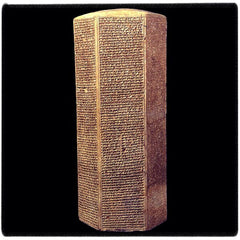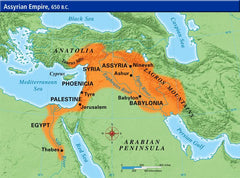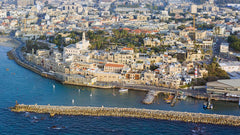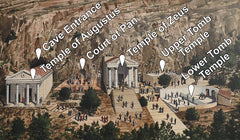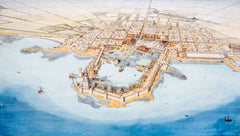Your cart is empty now.

Baptism Now Saves Us: A Spiritual Cleansing

There are therefore, two figures in 1 Peter 3:21: the flood, which is an Old Testament type of baptism; and water baptism, which is the New Testament picture (or the sign and seal) of salvation in the blood and Holy Spirit of Christ. The reality is salvation in Jesus Christ.
The Heidelberg Catechism elucidates: “Is then the external baptism with water the washing away of sin itself? Not at all; for the blood of Jesus Christ only, and the Holy Ghost, cleanse us from all sin” (Q&A 72). Water baptism, and its type, the flood, point to one great reality: the washing away of our sins by the blood and in the Spirit of Jesus Christ. Peter teaches this when he writes: “The like figure whereunto even baptism doth also now save us…by the resurrection of Jesus Christ” (v. 21). Peter connects salvation not to water baptism, but to the resurrection of Jesus Christ, and therefore also to the cross. There is no resurrection without the cross, for the resurrection of Jesus Christ is his bodily resurrection from the grave three days after his death.
Peter has already explained the death of Christ in verse 18: “For Christ also hath once suffered for sins, the just for the unjust, that he might bring us to God.” Christ’s death was a substitutionary death, an atoning sacrifice to satisfy God’s justice. We are unjust or unrighteous, and Christ, the just one, paid for our sins. Thus Christ died both for our benefit and in our place, and by his resurrection God proves that he is perfectly satisfied with his Son’s work of atonement.
So we see the relationship between three things: the flood, water baptism, and salvation in the blood of Christ. The flood is the Old Testament type of salvation in the blood of Christ: by the waters of the flood Noah was separated from the wicked world and consecrated to God, but the waters of the flood did not wash away Noah’s sin or bring him to heaven. Baptism is the God-appointed New Testament sign and seal of salvation in the blood of Christ: as the waters of baptism wash away the dirt of the body, so the blood and Holy Spirit of Christ justify us and sanctify us from the guilt, pollution, and bondage of sin. But what is true of the flood is also true of baptism (it is not the reality): neither the water of the flood nor the water of baptism wash away sins. They are but God-appointed pictures of the true washing in the blood and Spirit of Christ. Or to use the language of sacraments, they are signs and seals.
The blood of Christ is the antitype or the New Testament fulfillment—not water baptism.
Lest we misunderstand Peter, he immediately adds this qualification (which appears as a parenthetical statement in the KJV): “not the putting away of the filth of the flesh.” What does Peter mean by this? The “filth of the flesh” is sin—our sinful, polluting, corrupting nature. That, says Peter, is not put away when a person is baptized with water. Peter is not saying here that the water of baptism does not wash away or have the power to wash away physical dirt and filth from the body. The “filth of the flesh” in verse 21 is not physical dirt: mud, grime, and filth. If the “filth of the flesh” were physical dirt, Peter would not be saying anything particularly profound (of course, no one uses water baptism as a means to become physically clean—we bathe or take a shower for that purpose! We do not submit to baptism!). Besides, strictly speaking, it would be incorrect to say that baptismal water does not wash away dirt, for it does have that power, although baptismal water is not usually applied in sufficient quantities to remove dirt from the body, nor do we scrub our bodies in baptismal water to achieve physical cleansing. Instead, the “filth of the flesh” is moral evil; and the putting away of the filth of the flesh is spiritual cleansing from sin. This phrase is similar to a phrase found in Colossians 2:11: “In whom also ye are circumcised with the circumcision made without hands, in putting off the body of the sins of the flesh by the circumcision of Christ.”
Notice what Paul in Colossians 2:11 and Peter in 1 Peter 3:21 are saying: neither apostle is speaking of a cleansing from dirt. Paul teaches that Christ puts away our sinful flesh when he regenerates us (which, he says, is equivalent to spiritual circumcision made without hands, the circumcision of the heart celebrated in the Old Testament in passages such as Deuteronomy 30:6). Peter teaches that baptism does not put away our sinful flesh. The putting away of the body of the sins of the flesh occurs in regeneration; it does not, says Peter, occur in baptism: “not the putting away of the filth of the flesh” (v. 21).
So baptism, says Peter, saves us as a figure (“the like figure whereunto”), but it does not put away the filth of our flesh. In other words, water baptism does not remove our sins: it does not justify and it does not sanctify us. Peter, therefore, does not teach baptismal regeneration. Baptismal regeneration is the teaching of Roman Catholicism according to which the sacrament of baptism regenerates a person. By virtue of the act of baptizing by a priest, God gives a person spiritual life and Christ washes away a person’s sins. If the baptized person is an infant, baptism washes away his original sin; if the baptized person is older, baptism washes away both his original and his actual sins.
For example, the Catechism of the Catholic Church teaches, “By baptism all sins are forgiven, original sin and all personal sins, as well as all punishment for sin” (paragraph 1263); “The sacrament is also called the washing of regeneration and renewal by the Holy Spirit, for it signifies, and actually brings about, the birth of water and the Spirit” (paragraph 1215); “Through baptism we are freed from sin and reborn as sons of God” (paragraph 1213).
In other words, Rome teaches that baptism is “the putting away of the filth of the flesh,” something which the apostle Peter denies.
But we shall have more to say in a further blog post.
To be continued…
________
This post was written by Rev. Martyn McGeown, missionary-pastor of the Covenant Protestant Reformed Church in Northern Ireland stationed in Limerick, Republic of Ireland. If you have any questions or comments, please post them in the comment section on the blog.
The content of the article above is the sole responsibility of the article author. This article does not necessarily reflect the opinions and beliefs of the Reformed Free Publishing staff or Association, and the article author does not speak for the RFPA.

Donate
Your contributions make it possible for us to reach Christians in more markets and more lands around the world than ever before.
Select Frequency
Enter Amount

